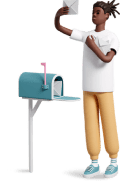How To Start an Online Store in 2024 (10-Step Guide)

Building an online store can feel daunting, but with the right tools, it’s easy to start selling online. Whether you’re a seasoned retailer or chasing your first sale, creating a store is the best way to reach customers and make a digital home for your brand.
Here are 10 steps that anyone can follow to start a successful online store.
To start an online store right now using Vighper, follow this startup guide.
How to start an online store
- Find a target audience
- Source your products
- Choose a commerce platform
- Design your brand
- Register your business
- Build your store
- Set up your checkout and shipping
- Make your store live
- Market your products and brand
- Optimize your store
1. Find a target audience

A target audience is the group of people who are most likely to show interest in your store and buy your products.
Knowing your target audience will guide your decisions as you build your store. It will help you look for customers in the right places and tailor your website’s content to their needs and preferences. A store that’s designed with a target audience in mind is more likely to attract interested shoppers and make sales.
You can target an audience of any size or attribute. However, there are three main audience categories to consider:
- Demographics: Your audience’s age, gender, occupation, education, income, and other characteristics.
- Location: The geographic markets where your audience lives.
- Interests: The hobbies, beliefs, lifestyles, and other psychographic qualities of your audience.
Compile these types of information about your audience into a buyer persona—a data-generated profile of your ideal customer. A buyer persona helps keep your audience in mind as you design webpages, write product descriptions, and create ads.
Discover your niche
As a new online store, you’ll likely be competing for your audience’s attention with established rivals. One way to side-step competitors is by catering to a niche within your audience.
Niche markets are segments of an audience defined by specific needs. For example, running shoes are a niche within the general footwear market. Trail running shoes represent a more specific niche for customers who need a certain type of running shoe.
Niches become increasingly specialized wherever there is market demand: you might sell waterproof trail running shoes, waterproof trail running shoes for snowy conditions, and so on.
If you’re planning to start an online store within a saturated industry, consider “niching down” until you find an audience in need of a go-to shopping destination.
2. Source your products

Finding the right products to sell is likely the most impactful step in launching your online store. If you already know your target audience, you’re ahead of the game. The internet, along with your social and work networks, can be treasure troves of consumer insights, helping you identify products your audience won’t be able to resist.
Pick a few of these strategies to help discover products that could become bestsellers:
- Engage with enthusiasts and hobbyists to learn about their challenges and the latest products they’re excited about.
- Leverage your personal passions and interests to understand what products will appeal to like-minded niche audiences.
- Monitor product trends to predict and stock the next popular item.
- Analyze what’s selling on major marketplaces to identify products that have sold strongly for years.
Once you have an idea of the type of products you want to sell, the next step is to source them. Here are some common product sourcing methods:
- Craft your products: If you have skills like woodworking or illustration, you might be able to create handmade products. This can attract customers looking for unique, bespoke, or luxury items.
- Buy products from wholesalers: Purchasing inventory from wholesalers gives you control over stock and ensures a steady supply of products.
- Manufacture products: Work with a manufacturer to produce original items or private-label products.
- Print products on demand: Print on demand is the act of customizing products with your designs. Print-on-demand services handle production and shipping.
Try dropshipping
Buying and storing inventory is only one way to manage your products. Other options include dropshipping—a retail model where the product supplier packages and ships orders on your behalf.
With dropshipping, you can sell a wide array of items in your store without needing to buy or store them. Once you receive an order, simply forward it to your supplier for fulfillment.
Find products to dropship and connect with dropshipping suppliers by adding a dropshipping app to your online store.
3.
4. Design your brand

To give your store a consistent and professional feel, you’ll need to consider branding. It’s not just about a logo or a color scheme; branding is about creating an identity that resonates through your images and content.
Create the following brand assets to use throughout your online store:
Brand values and mission
Decide what your brand stands for—its purpose, your unique selling proposition, and your promise to customers. These brand values will influence the look and feel of your store, informing design and color choices as well as the tone of your brand voice.
Store name
Whether you use your own name, an evocative term, or a literal description of what you sell, your store name is often the first touchpoint a customer has with your brand. If you need inspiration, try this free domain name generator to produce on-brand suggestions and see which name ideas are available as domain addresses.
Logo
A logo is a visual shorthand for your brand that lives across a wide variety of surfaces, from your store to the shelves of other retailers.
Lifestyle and product photos
Photos help illustrate the features and quality of your products, but can also help customers see how your product might complement their lifestyle. Use lifestyle photos to tell an aspirational story.
It’s easy to take product photos with a smartphone camera. For a professional finish, edit your photos using AI to generate on-brand background scenes.
5. Register your business

Depending on your location, the products you sell, and how you plan to operate, you may need to register your store with state and federal governments, as well as industry-specific bodies. Making your store an official entity can help protect your assets and enhance your credibility with customers.
Before diving into paperwork, assess what types of registration (if any) apply to your situation. If you’re a sole proprietor doing business under your own name, you may not need any type of legal registration.
Check with your city or county about permits or licenses for selling products. Even online stores may need a business license or home business permit. Other types of registration include:
- A tax ID number for paying federal and state taxes
- Trademarks to protect your business or product names
- Tax-exempt status for nonprofits
Consider your business structure
Not everyone needs a formal business structure, but understanding the options can help you make the best choice for your online store:
- Sole proprietorship: This is the simplest structure, ideal for a one-person operation. There’s no separation between personal and business assets, which means straightforward taxation but more personal risk.
- Partnership: Partners contribute resources like money, property, or skills and share profits and responsibilities. Partnerships are governed by an agreement to outline roles and shares.
- LLC (limited liability company): An LLC can protect your personal assets by legally separating them from any business debts.
- Corporation: This structure is for businesses planning to go public or seek extensive outside funding. Corporations offer strong protection but are more complex and costly to set up.
6. Build your store

With your target audience defined, products sourced, and brand developed, it’s time to bring everything together in your online store.
Set up basic store information
Start with the basics. Fill out your store’s essential information as prompted by your ecommerce platform. Here’s what to tackle first:
- Domain address: If you haven’t already, purchase a domain that matches your store name and configure it in your platform’s settings.
- Template or theme: If your store builder uses pre-built templates, pick one that matches your desired site design. Look for features like parallax scrolling or display boxes.
- Navigation: Create menus that link to essential pages, and consider sidebar or footer navigation for additional links. If your store has many pages, add a search bar.
- Logo: Place your logo across your store and don’t forget to update the favicon.
- Design elements: Colors and typography help express your brand. Customize these in your theme settings to match your brand guidelines. Use contrast to highlight buttons and limit font choices to two or three across your site.
Add your first products
Find the “Add a product” section of your platform to input all the content, assets, and details about your products.
Product descriptions
Product titles must be clear and descriptive to help shoppers and search engines identify your products.
Product descriptions are an opportunity to speak directly to your target audience in a voice they recognize, telling them why a product will improve their lives. When writing product descriptions, remember to:
- Consider who you’re speaking to (their language and knowledge level)
- Highlight key features using icons, illustrations, or bullet points
- Anticipate customer questions and act as a stand-in for their eyes and hands
Photos and media
Upload high-quality product photos in a consistent style and aspect ratio. Also consider videos, animations, or 3D models.
Use images to help customers imagine owning your product. Alongside product detail images, add lifestyle images that show your products in action.
In the image above, you can see how ReFramed uses product shots on plain backgrounds to show every detail without distraction. Further down the page, customers can also see lifestyle photos that help them envision the brand’s bed frames within the context of their own lives:

For product categories where customers might need more visual information, such as clothing or jewelry, use multiple photos that offer additional angles and details.
Product information
The next essential product data to add to your store is pricing. Set your prices by considering your costs as well as perceived value and competitor prices. As your store evolves, adjust your pricing strategy based on customer data and feedback.
Beyond price, add other product information to help you and customers navigate your catalog:
- Product specifications (materials, dimensions, and manufacturing processes)
- Product categories (e.g., men’s shirts and pants)
- Product variants (quantity, color, and size)
- Inventory details like stock keeping units and barcode information
- Tax settings
- Product tags and collections to organize products for specific audiences or sale events
Create informational pages
Beyond products, your store needs informational content to build trust, tell your brand story, answer common questions, and let customers know how to reach you.
Before you launch your store, create the following pages:
- Homepage: Design your homepage to help first-time visitors easily understand what you sell, while also helping returning visitors resume shopping. Remember to optimize for mobile viewing.
- Contact page: Your Contact page should make support accessible with contact details, a form, and options like live chat.
- About page: Use your About page to connect personally with customers. Include videos introducing yourself, images that explain your supply chain, and links to press mentions.
- Policy pages: This page states your commitments for returns, shipping, and privacy. Policies help customers buy with confidence but also protect you during customer disputes.
- FAQ page: An FAQ page gives fast answers to common consumer questions. You might choose to incorporate FAQs into your product and policy pages.
Now that your store is up and running, it’s time to spread the word and draw in shoppers.
Marketing is different for every business. Your strategy should involve a mix of creative content and marketing campaigns tailored to your brand and audience.
Leverage social media marketing
Social media marketing isn’t about maintaining a presence on every platform out there. Instead, it’s about making an impact where your target audience is most active. For example, if you’re aiming to engage with Gen Z, TikTok is essential.
The best social media marketing content feels natural to users. Try to create content that isn’t only promotional, but also valuable—think how-to videos, comedy skits, behind-the-scenes glimpses, or even livestreamed Q&A sessions.
Optimize for SEO
Many shoppers use Google to find stores, read product reviews, or compare similar items. SEO marketing makes your store discoverable when potential customers search online.
For example, MADE Everyday’s YouTube video, above, attracts potential customers by appearing in Google and YouTube results for queries like “how to make a quilt,” which are relevant to its product line.
To find search terms that your store might target with marketing content, use a free keyword research tool. Look for high-volume keywords that connect to your products.
Talk to shoppers via email
Email marketing is a channel suited to your customers and visitors to your store. Set up email flows to engage shoppers throughout their journey—from a welcome series to abandoned cart reminders and post-purchase follow-ups.
Consistent email communication keeps your brand top-of-mind, helping future campaigns land naturally.
10. Optimize your store

Building an online store is a continuous process. As customers visit your store and interact with content, you’ll begin to see where content is working, and areas where improvements could be made.
Analytics are central to store optimization. The process of reviewing traffic and sales data, and refining your content in response, should become a regular part of your business strategy.
Look for insights from store data sources, including:
- Site traffic: Identify where your visitors are coming from—Google searches, social media posts, or ads? Understanding your traffic will help you tailor your store content and optimize marketing efforts.
- Product sales: Monitor which products are selling and which aren’t. This will inform your inventory decisions, promotional strategies, and even product development.
- User behaviour: Analyze how visitors interact with your store, including your most-visited pages and most engaging content. Can you improve your store’s user experience to replicate your successes?
- Customer feedback: Regularly gather and review feedback. This direct input can tell you what customers appreciate and what they’d like to see improved.
Armed with information about how users are interacting with your content, you can make changes to enhance your conversion rate, turning more browsers into buyers.












